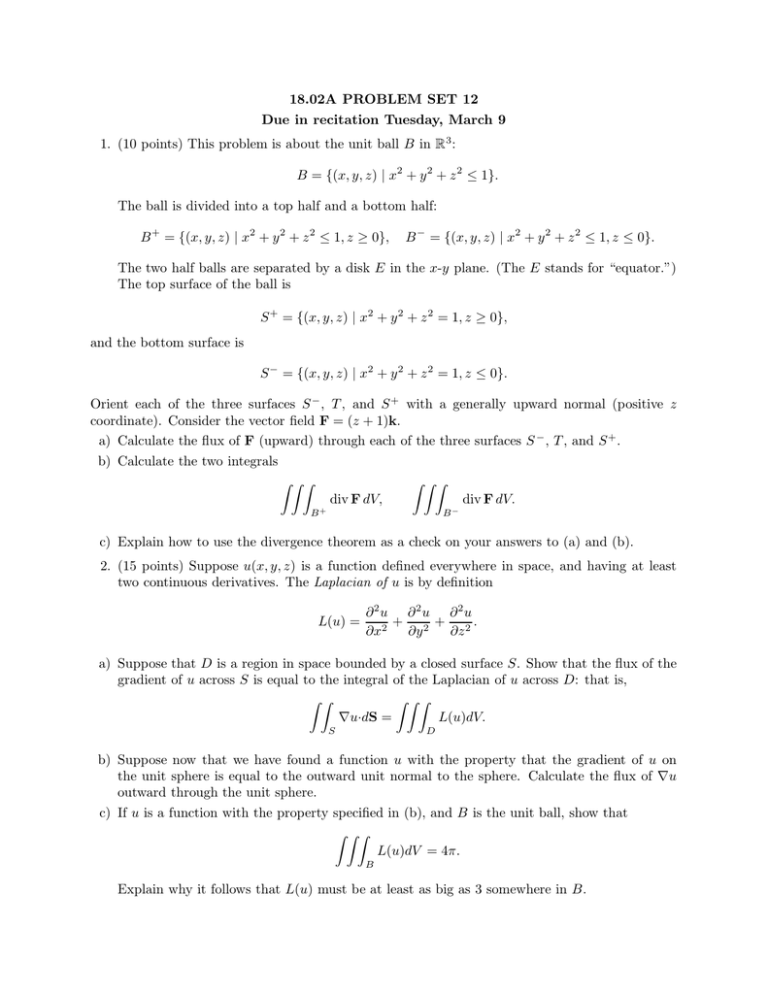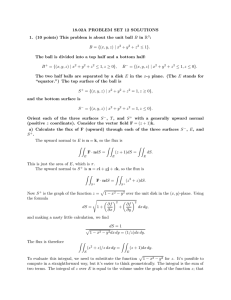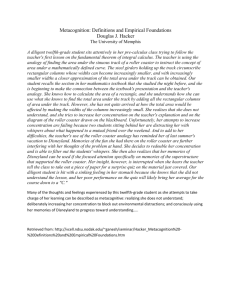18.02A PROBLEM SET 12 Due in recitation Tuesday, March 9
advertisement

18.02A PROBLEM SET 12
Due in recitation Tuesday, March 9
1. (10 points) This problem is about the unit ball B in R 3 :
B = {(x, y, z) | x2 + y 2 + z 2 ≤ 1}.
The ball is divided into a top half and a bottom half:
B + = {(x, y, z) | x2 + y 2 + z 2 ≤ 1, z ≥ 0},
B − = {(x, y, z) | x2 + y 2 + z 2 ≤ 1, z ≤ 0}.
The two half balls are separated by a disk E in the x-y plane. (The E stands for “equator.”)
The top surface of the ball is
S + = {(x, y, z) | x2 + y 2 + z 2 = 1, z ≥ 0},
and the bottom surface is
S − = {(x, y, z) | x2 + y 2 + z 2 = 1, z ≤ 0}.
Orient each of the three surfaces S − , T , and S + with a generally upward normal (positive z
coordinate). Consider the vector field F = (z + 1)k.
a) Calculate the flux of F (upward) through each of the three surfaces S − , T , and S + .
b) Calculate the two integrals
ZZZ
ZZZ
div F dV.
div F dV,
B+
B−
c) Explain how to use the divergence theorem as a check on your answers to (a) and (b).
2. (15 points) Suppose u(x, y, z) is a function defined everywhere in space, and having at least
two continuous derivatives. The Laplacian of u is by definition
L(u) =
∂2u ∂2u ∂2u
+ 2 + 2.
∂x2
∂y
∂z
a) Suppose that D is a region in space bounded by a closed surface S. Show that the flux of the
gradient of u across S is equal to the integral of the Laplacian of u across D: that is,
ZZZ
ZZ
L(u)dV.
∇u·dS =
D
S
b) Suppose now that we have found a function u with the property that the gradient of u on
the unit sphere is equal to the outward unit normal to the sphere. Calculate the flux of ∇u
outward through the unit sphere.
c) If u is a function with the property specified in (b), and B is the unit ball, show that
ZZZ
L(u)dV = 4π.
B
Explain why it follows that L(u) must be at least as big as 3 somewhere in B.
d) Find a specific function u with the property in (b), and find a specific place in B where L(u)
is at least 3. (Hint: part of what you want is that the gradient of u should be perpendicular
to the surface x2 + y 2 + z 2 = 1. What is the gradient of a function perpendicular to?)
3. (10 points) A roller coaster is designed with the parametric equations
x(t) = cos t,
y(t) = sin t,
z(t) = 1 − cos(3t),
The force of gravity on a roller coaster car is
F(x, y, z) = −mgk,
with m the mass of the car and g the acceleration of gravity.
a) Let C1 be the curve followed by the roller coaster from t = 0 to t = π. Calculate the work
Z
F·dr
C1
done by gravity on the car in traversing this path.
b) Same question, but now for the path C 2 followed from t = π to t = 2π.
c) Now we’ll move the roller coaster to a tiny asteroid, where the force of gravity is
E(x, y, z) = −
Calculate the work
Z
mg
k.
(z + 1)2
E·dr.
C1
(Hint: if you write out the line integral and compute, this is a little bit unpleasant. There’s
an easier way.)
4. (10 points).
a) Suppose f is a differentiable function of one variable, and F(x, y, z) = f (z)k. Show that F
must be conservative, and explain how to use f to find a potential function for F.
b) Suppose E is the vector field
E(x, y, z) =
1
(xi + yj + zk).
ρ
p
(Here ρ(x, y, z) = x2 + y 2 + z 2 .) The vector field is not defined at the origin. Show that
curl E = 0, and find a potential function for E.






